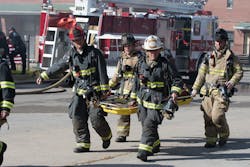Rapid intervention team (RIT) operations are a highly debated subject. Some believe RITs are ineffective and that the resources assigned would be more effective if they were assigned to interior operations. Others believe that RIT operations are a critical safety factor on the fireground.
Chief Don Abbott’s Project Mayday study has shown that a firefighter in a mayday situation is much more likely to either self-rescue or be rescued by firefighters who were already operating inside the building than be rescued by a RIT. In fact, Project Mayday reports that RITs account for only 11 percent of mayday rescues. All firefighters should review the study and understand when and how mayday situations most commonly occur as well as how most firefighters are rescued.
Regardless of your opinion of RIT, it is a fireground requirement. Effective RIT operations are dependent on proactive efforts by RIT members. A RIT that simply arrives on the fireground and stands in the street watching the firefighting operation take place is a failure.
Responsibilities and tools
Every member of the RIT should know their responsibilities before arriving on the fireground. These responsibilities should be laid out through the use of riding assignments. The responding firefighters will know prior to arrival that they will operate as the RIT, either because they were dispatched as a RIT or through department operating guidelines that assign the RIT to a company based on the order of arrival.
Upon arriving at the fireground, RIT members should gather their equipment and tools while the company officer performs a size-up and gets a report from the incident commander. While these tools and equipment will vary from department to department, they should at a minimum include:
- Radios (every member should have a radio)
- Flashlights
- Thermal imaging camera
- Forcible-entry tools
- Spare air supply for the firefighter in distress
Situational awareness
All RIT members must have strong situational awareness, as this will be a key factor in the team’s effectiveness if a mayday rescue must be performed. This requires all RIT members to constantly monitor the radio traffic to maintain awareness of the locations of the different units that are operating inside of the fire building as well as how long the units have been inside. Situational awareness also requires all RIT members to continuously size up the fire building. At all times the RIT members should be evaluating the situation and maintaining an awareness of how the interior operation is progressing.
Further, just because they have been assigned as RIT does not mean that these members cannot perform other operations on the fireground. In fact, RIT members have many other responsibilities, most notably ensuring adequate access and egress. This includes throwing ground ladders and softening the building (performing forcible entry and removing security devices). The key to effective proactive RIT operations is that the RIT members must remain ready and capable to deploy as a RIT and perform a firefighter rescue at all times.
Throw ground ladders
Ground ladders are an essential proactive RIT operation. Reduced staffing often means fewer ground ladders being used on the fireground, which increases the risk to interior firefighters. Attempting to place a ladder to every above-grade room rather than every above grade-window is a much better tactical use of the staffing and equipment. Placing a ground ladder to every room may be a difficult task, but the RIT should work to throw a ladder to at least one window on each side of the building on every floor that firefighters are or will be operating. If this is not possible, the RIT must ensure that at an absolute minimum two ground ladders placed on different sides of the building from each other on floors which firefighters are or will be operating. The goal for proactive ground laddering during RIT operations should be a tactical use of the available manpower and ladders rather than simply attempting to empty the ladder bed or “painting the building with ladders."
These ground ladders will improve the effectiveness of the RIT if they need to perform a vent-enter-search (VES) operation to rescue the firefighter on an upper floor. This eliminates the need to enter through the front door and search the entire building just to reach the firefighter. Ground ladders can also improve the ability of the mayday firefighter to self-rescue and the ability of other interior firefighters to rescue that firefighter should they find a window with a ground ladder already in place.
RIT members must also assist firefighters operating on the roof. At a minimum, the RIT should ensure that at least two ladders have been deployed to the roof to provide the firefighters with a primary and a secondary means of egress. The two ladders should be on opposite sides of the roof team’s operating position. The RIT must also ensure that at least one ladder is on the uninvolved side of the roof team’s position.
In addition to throwing ground ladders, the RIT should also ensure that all ladders placed by other firefighters are properly positioned. All ladders that have been deployed to windows should be positioned for rescue by positioning the tip of the ladder just below the window sill. All ladders that have been deployed to the roof should be positioned with the tip of the ladder extending three to five rungs above the roof to assist the roof firefighters in locating the ladder.
Soften the building
Softening the building is another critical proactive RIT operation. This includes forcing doors and removing devices such as security bars from windows. The purpose of this is to ensure quick access into the building by the RIT in the event of a firefighter rescue situation. Like the deployment of ground ladders, softening the building also improves the ability for a firefighter to self-rescue or for the firefighter to be effectively rescued by other firefighters who are already operating on the interior of the building. Forcible entry should be performed by a single RIT member to allow the other RIT members to perform other proactive RIT operations. Forcible-entry tool selection is key. While a single firefighter can effectively force entry through many doors, especially residential doors, with a Halligan and a flat-head axe, some firefighters have found further success by adjusting the tool selection. This can be seen by looking at the forcible entry operations of the Boston Fire Department where the flat head axe is replaced by a 3-pound maul.
Forcing entry during proactive RIT operations involves more than simply forcing the door open. Once opened, the firefighter should do two things before closing the door. First, the firefighter should search the area behind the door. The firefighter must maintain an exterior position while conducting this search by remaining in contact with the door frame as his/her assignment remains RIT. Studies have shown that approximately 10 percent of victims who were rescued by firefighters were found within 6 feet of a door.
Second, the firefighter must also ensure that the door will not again lock when it is closed. This can be as simple as applying a rubber lock cover over the door handles. The door can then be closed to prevent creating a flow path in the building, but still proving a quick access point into the building for the RIT. Every door of the building should be forced, searched and secured in this manner during proactive RIT operations.
Safety devices such as security bars (burglar bars) that have been installed on windows must also be removed when softening the building. The firefighter assigned this task must ensure that the window itself is not broken during the removal of the security bars. The goal of this operation is only to remove the obstruction that would prevent the rescue of a firefighter from being performed using the window, not to ventilate the window. Most security bars can be removed with simple hand tools, such as a Halligan or a steel roof hook for security bars that are installed on the outside of the wall and a flat-head axe or a sledge hammer for security bars that are set inside of a brick or block wall.
Additional activities
Hoselines are another area that should receive attention from RIT members. While the engine company should have removed all kinks, the RIT should recheck the hoselines for kinks and remove any that the engine company may have missed. A charged hoseline is the best option available to firefighters to prevent many firefighter emergencies. The key to the charged hoseline is an adequate flow rate. Kinks can reduce the flow rate by up to 30 percent.
Once all of the above activities have been performed, the RIT can perform any other activities that may have been neglected due to the reduced staffing that many fire departments experience. One of these activities is to control the building’s utilities. This should have been performed by the truck company, but if reduced staffing has prevented this activity, the RIT should control the building’s utilities.
In sum
RIT operations, while not necessarily the most sought-after assignment on the fireground due to its exterior position, can be the difference between a successful and unsuccessful firefighter rescue operation. Proactive activities by the RIT are some of the most impactful activities related to firefighter rescue that will be performed. The mindset of every RIT member should be to hope that they are not needed, but to ensure that everything is done in advance so a firefighter in trouble will be given every opportunity to survive. The attitude that RIT is in place only to perform a firefighter rescue must be eliminated and replaced with the attitude that the RIT is responsible for improving the ability of themselves as well as all other firefighters on scene to perform a firefighter rescue. The goal must be the successful outcome of a firefighter rescue, not who performs the rescue.
Reference
Abbott, D. “The Mayday Project” Firehouse Magazine. February 2016, pp. 46-48. www.firehouse.com/article/12156553/the-mayday-project

Anthony Rowett Jr.
ANTHONY ROWETT Jr. is a captain with the Mobile, AL, Fire Rescue Department. He was previously a firefighter with the Ogdensburg, NJ, Fire Department. Rowett has an associate’s degree in fire science technology from County College of Morris, NJ, a bachelor’s degree in fire science, and a master’s degree in emergency services management. He is a contributing author for multiple fire service publications and has presented at multiple fire service conferences. He has also served as a lead HOT instructor for a hoseline operations class at the Metro Atlanta Fire Fighters Conference. Rowett is the founder of Port City Fire Training. He can be reached at [email protected].






